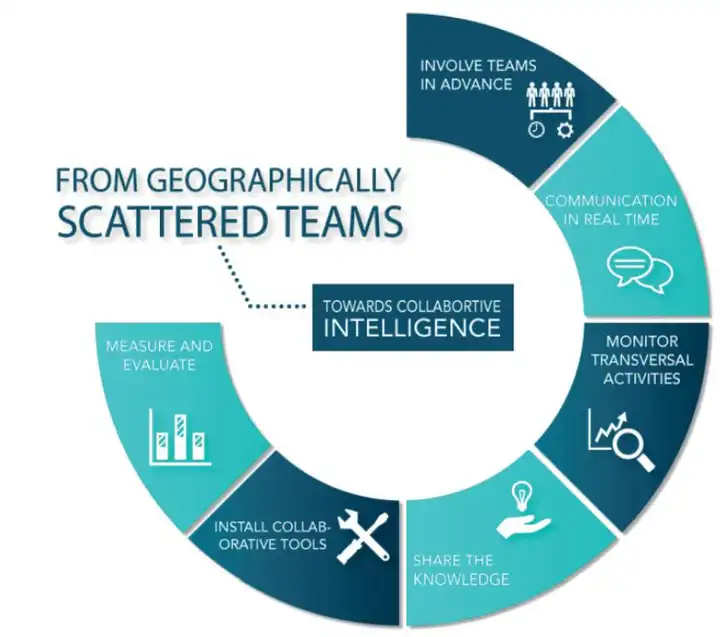
8 minute read
Creating collaborative Intelligence
by PMI-México
Publirreportaje
From scattered teams to collaborative intelligence
Advertisement
By Planisware
In an information economy, enterprise performance depends critically on its stakeholders’ collective knowledge and intelligence – and increasingly on the quality of distributed teams’ collaboration to mobilize that knowledge.
As we have seen, deployment of teams’ knowledge and intelligence is enhanced by effective tools and techniques for collaboration and knowledge sharing across time and distance.
With collaborative tools, distance among team members need not hinder the cohesion of teams and the development of a team spirit. Collaborative tools, however, are not enough. Temporal, organizational, socio-cultural, technological and other criteria besides geographical distance must also be taken into account.
In « Eight Ways to Build Collaborative Teams » Lynda Gratton and Tamara J. Erickson examined 55 large, complex, and highly collaborative teams and statistically analyzed more than 100 factors that might contribute to collaboration. From those 100+ factors, they found eight that correlated with success in overcoming problems of long-distance communication, team size, diversity, and specialization.
1. « Signature » Investments. Management can encourage collaborative behavior via very visible investments showing their commitment to collaboration (e.g., in facilities with open floor plans for better communication).
2. Behavior Modeling. In enterprises where senior executives show highly collaborative behavior themselves, teams collaborate well. 3. A « Gift » Culture. Encouraging managers to give the « gift » of mentoring and coaching— especially on an informal basis— helps people build personal networks, which are often key to working across corporate boundaries.
4. Teach Vital Skills. Human resource departments or other organizational units can positively affect team collaboration by actively teaching managers and staff how to build relationships, communicate well, and resolve conflicts creatively.
5. A Strong Sense of Community. People are more likely to both reach out for help and to share knowledge when they feel a sense of community.
6. Team Leaders Who Are Both Task- and Relationship-oriented. Rather than debate whether a task or a relationship orientation creates better leadership, recognize that both are key to successful team leadership. Usually, emphasizing task orientation early in a project, and then shifting toward a relationship orientation when work is well underway, works best.
7. Build on Heritage Relationships. People are reluctant to share knowledge and less comfortable collaborating when too many team members are strangers. A best practice is to appoint a few people (at least) who know one another to the team.
8. Role Clarity and Task Ambiguity. Cooperation grows when team members’ roles are sharply defined yet the team has latitude on how to complete its work.
By Matt Light Planisware’s Vice President for Strategy & Corporate Development.

CREATING
COLLABORATIVE INTELLIGENCE ON DISTRIBUTED PROJECT & PROGRAM TEAMS

Part Four
SOURCE: HARVARD BUSINESS REVIEW, NOVEMBER 2007, Lynda Gratton and Tamara J. Erickson
On individual projects, often teams are assembled reactively, and over time, organizations gradually gravitate toward remote work reactively, often almost randomly. However, executives and managers can implement intentional steps both to build a culture of collaborative teams – « collaborative intelligence » – and to promote successful programs and projects. Specifically, six steps – from involving individual members early, to measuring and evaluating project collaboration activities – will enhance team productivity and quality of product deliverables, while contributing to development of collaborative intelligence .

Six Steps to Achieve Collaborative Intelligence
5.1. Involve Employees in Advance 5.2. Communication in Real Time
Technologies like those previously mentioned and others have enabled more real- time communication by distributed teams, but cannot overcome differences in time zones, especially when those differences are four or eight hours or more. As a result, in addition to leveraging collaboration and communication tools, organizations have learned the importance of identifying the most convenient time for an intercontinental team to meet, establishing those standing meetings at set times, and adhering strictly to a meeting schedule.
If no time is convenient, because some team members have nine-to-fifteen hour time differences, then as previously noted it is necessary to share the inconvenience, with one region taking an evening teleconference (e.g. Thursday evening 8:00 p.m.), and then, for the next meeting, the other region taking an early morning call (e.g., Wednesday morning 7:00 a.m.).
Recording calls for absent members to listen to is no substitute for real-time communication, not only because the recordings are seldom listened to, but because they do not involve the immediate exchange of ideas, counter-proposals, debate, and the Q&A of a real meeting.
5.3. Monitor Transversal Activities
For several years now enterprises have sought to adopt more horizontal, or « flatter,» management approaches, both to gain efficiencies and to promote closer communication between management and staff.
The first step in the journey towards collaborative intelligence is team participation in decisions that affect them and their work. As enterprises adopt more agile and lean management techniques, establishing goals and performance targets has become more iterative and co-operative. Involving employees in decision-making encourages dialogue among all levels of scattered teams. This more participative management method helps cultivate a collaborative organization. It enables enterprises to federate participation, facilitating people’s involvement and attracting their support of program goals, whatever their level of maturity or role (operational, strategic, funding, clients, etc.), and regardless of their geographical location. Vertical management structures remain, to provide good control of business activities, but enterprises also have more and more projects and product lines that span multiple departments (e.g., commercial, logistical, financial, etc.), with teams based all over the world. This has led many to blend transversal, intersecting vertical and horizontal management practices, which requires higher levels of collaborative intelligence, bringing many important organizational and technical challenges.
To address these challenges, collaborative project portfolio management solutions can help bring stakeholders together on a common platform to bridge the
20
gap between project planning, decision-making and operations. They provide a comprehensive view of the transversal activities of planning, monitoring and analysis. They thus promote both strategically steering programs and operational responsiveness in tracking project costs and delays.
5.4. Share the Knowledge
Companies with high collaborative intelligence are characterized by the collection and sharing of knowledge gained from every project. Unfortunately, very often, the most relevant and valuable information for a project or program is not recorded in any database, but resides only in the minds of past project participants. The inability of most organizations to share properly gathered, digitally archived, and intelligently indexed knowledge means they typically incur a significant opportunity cost. The benefits of collaborating across time, sharing knowledge gained on past projects to improve planning and mitigate risks, are substantial, but those benefits elude organizations incapable of knowledge management.
Collaborative project portfolio management solutions can yield such benefits and others by enabling users to access, modify, and exchange data and knowledge directly in a common online workspace across the organization. Team members and other stakeholders can search, view, and retrieve vital knowledge (and without the inconvenience of having to connect to a local server or download email attachments).
5.5. Install Collaborative Tools
Collaboration of distributed teams is supported by a range of different kinds of tools and technologies. Social networks, video- or teleconferencing, Internet platforms (intranets or Web-based), and others are widely used to help teams work together.
In a virtual enterprise with high collaborative intelligence, collaborative project portfolio management tools are accessible – not only to project managers or to program, portfolio, resource, or other managers – but to all team members. Applications like Planisware Orchestra let all participants create and control their own project activities, coordinate their work through shared calendars, and communicate in real-time with feedback, alerts, and notifications, while also enabling managers to prioritize, plan, schedule, assemble teams of complementary resources, and monitor cost and progress. Existing solutions have different modules for each role or specialty. For example, a calendar centralizes important appointments; instant messaging and group chat reduce the amount of e-mail and facilitate quicker communication across the entire team; a wiki or a blog lets teams easily share information. Collaborative project portfolio management solutions are designed so that each completed task can trigger a chain of information to other collaborators.
5.6. Measure and Evaluate
The sixth step, measurement and evaluation taken together, is perhaps the most important in cultivating collaborative intelligence – and the most difficult, in its multidimensional complexity. One dimension is to measure and evaluate projects, not just in budget and schedule terms, and not just in terms of risk mitigation, or their business case, and user or customer satisfaction.
Those and other factors can provide important data for future use. But another dimension is evaluation of that data – such as finding the rationale for changes to project schedules or budgets, or even business cases – and that is where future project managers will find more useful project and/or portfolio knowledge.
Yet another dimension is measurement and evaluation of collaboration practices themselves. To what degree are team members involved in decision-making and goal-setting? Is real-time communication declining, replaced by email and recorded (but seldom listened to) meetings? What is the blend of formal, informal, vertical, and horizontal management practices, and how is that blend changing? How does management set targets for the roles and activities focused on collecting, indexing, and disseminating project knowledge? Is that management function supported by tools? What is the rate of usage of collaborative tools, including the amount of new content, team commentary, and reusable artifacts like templates?
From a human, organizational and technical perspective, these collaborative best practices will help enterprises continuously improve organizational performance. Implementing collaborative best practices, as learned in diverse business situations and from successes and failures past, will deliver the biggest added value when supported by consistent measurement, evaluation – and action.







